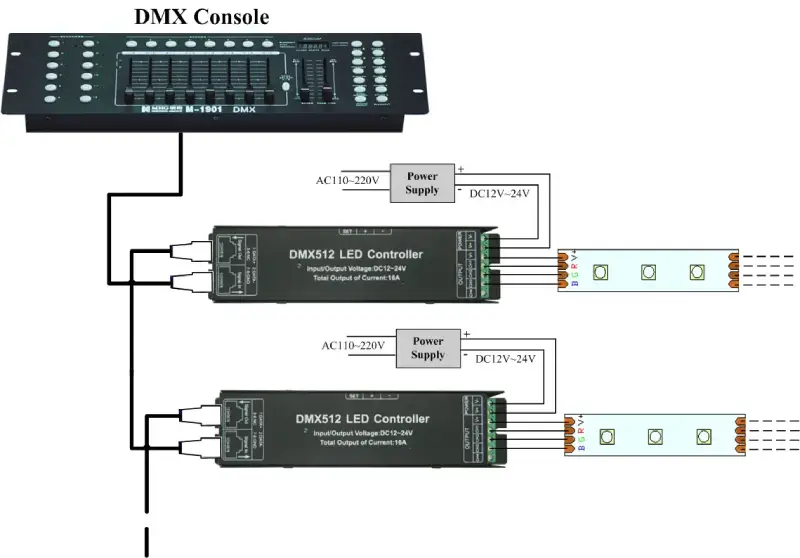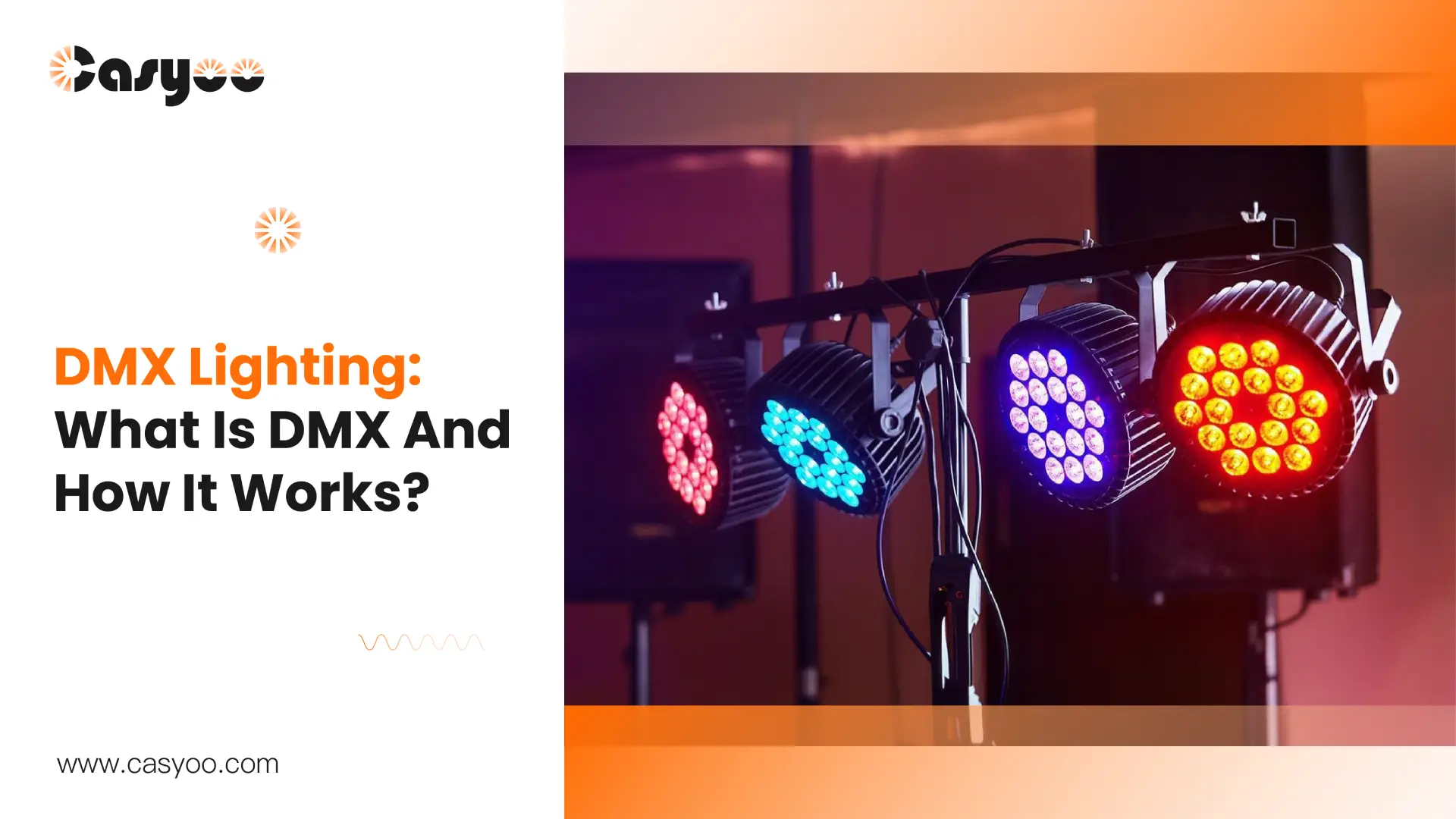DMX stands for Digital MultipleX, which means multi-channel digital transmission. The DMX system can perform digital transmission dimming and has 512 channels. The DMX controller transmits control signals such as brightness, contrast, and color, and changes the lighting effects of the lamps. How does it work to control the lights? What are DMX cables? What about the controller and wireless solution of DMX? In this passage, we will provide a comprehensive introduction of what is DMX. You will be sure to get your question answered!
How does the DMX system work?
The host first sends the dimming data via the program to the DMX controller. The signal from the controller is then received by the decoder in each bulb. To control the LED light, it transforms the DMX signal into an analog signal. Each light is given an address number that is used to direct the DMX512 control signal. The lights will only respond to control signals that belong to them. As a result, the signal is decoded at varying speeds, producing a range of shifting illumination effects.
Usually, one lamp is controlled by each channel, and the channel value indicates the dimming level. Lamp 3’s brightness, for instance, is 50% when a value of 127 is sent to channel 3, and 100% when a value of 255 is sent. Multiple channels may be occupied by lamps that have extra functions; the values of these channels may indicate dynamic effects, color, dimming, etc. Here’s an example:
A multifunctional lamp occupies 14 channels. Each channel controls the following functions:
- Channel 1: X-axis rotation of the lamp head
- Channel 2: Y-axis rotation of the lamp head
- Channel 3: dimming
- Channel 4: Strobe effect – 0~10: Light off; 11~250: Light on for 10 seconds and then off for 10 seconds; 251~255: light on and no strobe
- Channel 5/6/7/8: Control RGBW color light to create light with different colors. When the values of 5, 6, and 7 channels are all 255, the lamp emits white light.
- Channel 9: Pattern shape – 0~10: No pattern; 11~50: Five-pointed star; 51~100: Circle; 101~150: Flower; 151~200: Small animal; 201~255: Block
- Channel 10: Drift speed of pattern – 0~10: Fixed; 11-255: Gradually faster
- Channel 11/12/13/14: RGBW light that changes the color of the pattern
Connection of DMX system
How does the DMX controller work?
The working principle of the DMX512 controller can be simplified as follows:
- Connect the lighting equipment to the DMX512 controller with a standard DMX plug.
- Use the software to program the DMX512 controller and set the values of each channel.
- The software converts the written program into the DMX512 protocol and sends it to the DMX512 controller via the data line.
- After receiving the transmitted data, the DMX512 controller parses the data packet and passes the corresponding value to the lighting equipment.
- The lighting equipment adjusts the brightness, color, movement, and other parameters according to the received values and achieves different lighting effects.

How to connect lights to DMX?
- Single signal terminal wiring method
The simplest wiring technique is single signal terminal wiring, which connects the controller and lighting equipment via a single signal line. Through a signal line, the controller sends the DMX512 signal to the first lighting device. The signal is then sent straight to the next device via the device’s signal output port. This technique works well for managing a few lighting fixtures.
- Main signal terminal wiring method
The controller and the lighting device are connected by a signal line in the main signal terminal wiring approach as well, but the final device often has a terminal resistor. The terminal resistor’s function is to provide steady signal transmission by preventing signal reflection.
- Splitter wiring method
The splitter wiring method is ideal for controlling a large number of lighting devices. Through a main signal line, the controller sends the DMX512 signal to the splitter, which splits it into several branches that connect various lighting fixtures. There are two types of splitters: passive and active. Although passive splitters don’t need external power, they could attenuate and delay signals. Active splitters can provide steady signal transmission.
- Independent wiring method
Large-scale performances and stage equipment control frequently employ the independent wiring method. A signal wire and a ground line will connect each device. Separating the signal and ground wires can help to reduce signal interference and improve signal transmission quality.
What are DMX cables?
With a length of 100 to 400 meters, the DMX512 bus network can link up to 32 loads, or individual devices. If there are more than 32 unit loads, we will install a DMX splitter to extend the network via a parallel bus. In the DMX system, we often use the shielded twisted pair cable.
How does wireless DMX work?
We can achieve intelligent control of LED lights by integrating a wireless transceiver module and micro controller into the DMX control system. The microprocessor receives and processes the commands that users enter through buttons. The wireless transceiver module receives control signals and sends them to the DMX circuit signal sending module, which in turn sends data to the DMX control module. It will then control the lights and change the lighting effects.
Difference between Dali and DMX
In the following table, we have compared Dali and DMX from different aspects:
| Dali | DMX | |
| Lighting effect | static | dynamic |
| Application | indoor lighting | stage lighting |
| Information transmission | two-way communication, and support querying decoder status | one-way communication |
| Protocol | complex, with more than 200 protocols | simple |
| Communication bus | low-voltage carrier | RS485 |
| Frame structure | Manchester code | In line with the serial communication UART data structure |
| Baud rate | 1200 bit/s | 250K bit/s |
| Relationship between the host and devices | one-master-multiple-slave structure, with a maximum of 64 slave addresses/multi-master-multiple-slave structure | one-master-multiple-slave structure, with a maximum of 512 slave addresses |
| Bus | ordinary 2×1.5mm wires | Differential cable |
| Maximum refresh rate | no refresh rate (static effect). The parameters are all stored in the slave decoder | 44 frames/second (dynamic effect). The parameters are all stored in the host, so the host has a large workload. |
| Address setting | manually or automatically assigned by the host | manually |
| Number of groups | fixed, with a maximum of 16 groups | depends on the host |
| Number of scenes | fixed, with a maximum of 16 scenes | depends on the host |
DMX lighting FAQ
- What happens if you use XLR cables in DMX system?
A lot of customers use more easily purchased audio signal wires. However, improper signal cables may cause a significant number of failures. The multiple fiber cables and metal mesh shielding layers make DMX signal cables qualified enough for performances. XLR signal wires are likely to be broken. Furthermore, because some devices require bidirectional signal or power transfer, it is advised that the DMX system include two twisted pair shielded wires.
- Is DMX 3 or 5 pin?
The DMX protocol requires the use of a five-core pin connector, but usually only three are used. For those devices that need to send signals to the console, a five-core pin is required.
- Why are the lights not responding to my DMX controller?
Use a temporary controller to test whether the circuit can be controlled:
- Responding – There is a problem with the signal output of the original controller (wiring problem or port hardware problem).
- Not responding- To ascertain whether the issue is with the controller or signal interference brought on by the subsequent lamps, disconnect the lights after the first one and test the first lamp by itself. Continue connecting the subsequent lights to determine the issue’s location if the first one responds.
Conclusion
We have explained how the DMX lighting works to control the lights, how the devices connect with each other, and the differences between Dali and DMX. Besides, we also provide the answer to some frequently asked questions. We hope this passage can help you get to know the DMX lighting system more. Check Casyoo RGB flood lights that can perfectly work with DMX system!




